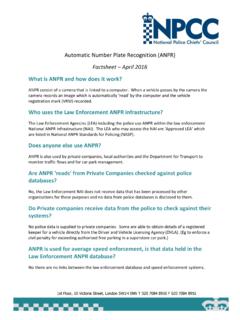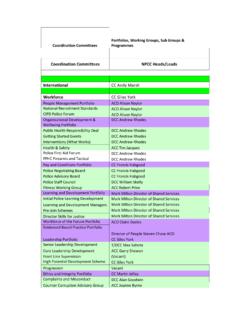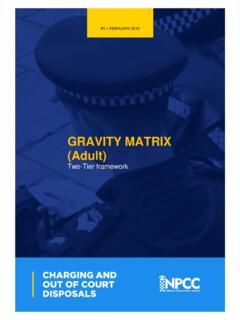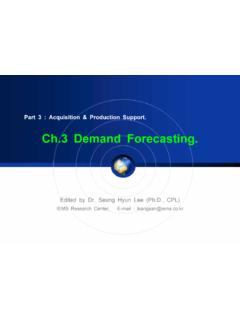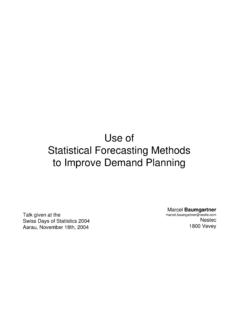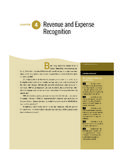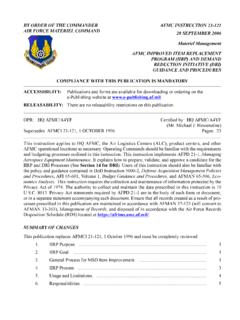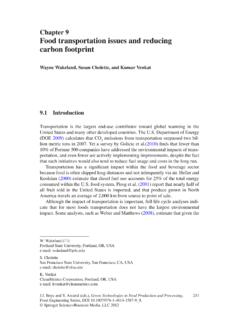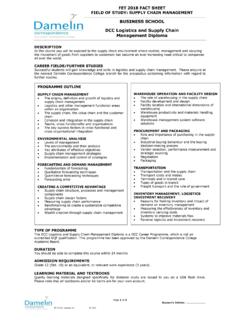Transcription of Better Understanding Demand Policing the Future
1 Better Understanding Demand Policing the Future NPCC Performance Management Coordination Committee 2017 Trending Demand Time Peak Demand Base Demand Snapshot at any time Public Demand Protective Demand Internal Demand Copyright NPCC 2017 Page 2 Contents Contents .. 2 Foreword by Chief Constable Steve Finnigan CBE QPM .. 3 Executive Summary .. 4 Introduction .. 6 Summary of 9 Summary of Recommendations .. 11 The Demand Reference Group .. 14 Chapter 1: Demand in Context and Whole System Thinking .. 16 Chapter 2: Towards a Common Understanding .. 19 Chapter 3: Legitimacy of Demand and Public Expectation .. 23 Chapter 4: Vulnerability .. 28 Chapter 5: Demand Management - A Case Study .. 34 Chapter 6: Demand Management - MoRiLE .. 39 Chapter 7: Demand Management - THRIVE .. 42 Chapter 8: Internal Demand .
2 48 Chapter 9: Demand , Efficiency and Effectiveness - PEEL Inspections .. 52 Chapter 10: Big Data .. 56 Chapter 11: Predicting Demand .. 59 Chapter 12: What we can t Predict A Co-ordinated Plan for Future Research .. 71 Chapter 13: Productivity .. 73 Chapter 14: Resourcing .. 82 Chapter 15: Process Mapping and Value Streams .. 88 Chapter 16: Demand and the funding formula .. 92 APPENDICES Appendix 1: Table on Tackling Vulnerability .. 97 Appendix 2: Sample Internal Audit Form .. 98 Appendix 3: Demand Prediction requiring further Research .. 100 Appendix 4: 102 Appendix 5: Internal Demand in the MPS .. 103 References .. 104 Copyright NPCC 2017 Page 3 Foreword Steve Finnigan CBE QPM Chief Constable of Lancashire Constabulary and NPCC Chair of the Performance Management Coordination Committee (PMCC) There is no doubt that Demand is changing in nature and much of it as a result of our revised approach to risk, threat, harm and vulnerability (R/T/H/V).
3 Understanding Demand across the breadth of our business is critical. In recent years the Police Service has seen change on an unprecedented scale and is striving to transform in ways that will enable us to meet new types of Demand with fewer resources. Austerity has also led to some partner services shrinking apart; this has undoubtedly impacted on Demand , capacity and capability. We now also have a new performance narrative, focusing on R/T/H/V, as well as an increase in complexity. This piece of work to Better understand Demand , commissioned by the NPCC Performance Management Coordination Committee, has engaged with the service, as well as partners, to develop a clearer Understanding and more consistent picture of Demand that recognises the changing nature of R/T/H/V within our communities.
4 Critically, it also seeks to examine the key levers that may enable the service to more accurately predict Future Demand . The project has adopted a broad classification of Demand into three domains, namely Public Demand , Protective Demand and Internal Demand . This is with a view to developing a consistent and considered approach to Better understand the Demand that we face, to be clear on how we can manage it, to support the tough decision making that prioritises service provision, as well as helping our managers and leaders to plan and then deploy resources in the most effective and productive way possible. It is the second part of a project that set out to quantify Demand and to aid our Understanding of its importance in the management of modern day Policing . In the first part, the College of Policing sought to quantify the totality of Demand .
5 In this work, Demand was broadened out beyond calls for service to everything that the Police Service does to assist people in our communities. It tries to explain Demand , offering a common language for discussion. It has linked Demand to public value, in terms of how the services expected and delivered add to public value, as well as using academic research and other wider initiatives to develop Demand forecasting models. The guidance also seeks to develop ways for data to be converted into management information linked to R/T/H/V to guide the allocation and deployment of resources. The project has been assisted by an established Reference Group of volunteers from across the service who have shared good practice, provided professional opinion, reality checked options, and applied practitioner critique to the project outputs.
6 A Task and Finish Group was also established to feed the learning from the work on Understanding Demand into the current thinking around the Police Funding Formula Review. Finally, I would like to thank all those who have contributed to this guidance for their commitment and assistance. Copyright NPCC 2017 Page 4 Chief Constable Steve Finnigan Executive Summary The PMCC of the National Police Chiefs Council (NPCC) commissioned a project into Better Understanding Demand on the Police Service. The first part of the project was conducted by the College of Policing and resulted in a report published in January 2015. However, the NPCC felt that there was further work to be completed in order that Understanding and awareness of Demand could be raised across the service and its partner agencies.
7 Within this, the NPCC were keen to increase the debate around the Demand that is passed to the Police from other parts of the public sector, including the expectations of other agencies and the public. It was argued that the police needed to define Policing Demand beyond just calls for service and to Better understand the demands presented through our daily management of R/T/H/V. It was also important to develop a new Understanding of the totality of Demand on the Police Service that could inform the Police Funding Formula (PFF) review. The scope of the project was set out in the agreed Terms of Reference and included: 1. Examine Demand beyond recorded crime 2. Explore sources of Demand data and how this can be converted into management information 3. Consider the impact on Demand of collaborative working 4.
8 Consider Demand in the context of whole system thinking 5. Identify on-going professional good practice across the service and set up a central repository to avoid duplication of effort 6. Establish an Independent Advisory Group drawn from various sectors to act as a critical friend throughout the project 7. Link Demand to public value in terms of how the services expected and demanded add to public value 8. Utilise current academic research and wider initiatives to develop Demand forecasting models 9. Explore the relationships between Demand , productivity and resourcing 10. Identify and acknowledge the potential of digital capabilities such as Big Data 11. Consider the leadership and management skills required of leaders, managers and supervisors to use Demand information as part of their supervision and management practices The project commenced in May 2015 and established a Demand Reference Group of volunteers drawn from across the service with representatives from all forces, non-Home Office forces, Police and Crime Commissioners Office, HMIC, Home Office, Federation, Superintendents Association, other emergency services, partners agencies and academia.
9 The Reference Group established specific work streams to cover topics to consider within and to deliver against the terms of reference. Each of these work streams was led by volunteers from across a number of different forces. Copyright NPCC 2017 Page 5 As outputs, the group provided regular update reports to the PMCC and delivered National conferences/workshops which not only raised awareness of Demand but also encouraged debate across the service as well as disseminate good practice. The collective work of the Reference Group work streams was then collated into the production of this guidance, referred to as, Better Understanding Demand - Policing the Future . The main findings and recommendations are detailed further within the document but can be summarised as.
10 Demand on the police service goes far beyond calls for service and can be categorised into three kinds of Demand - Public Demand Protective Demand and Internal Demand however, the approach to these is inconsistent across UK Policing The work of the Police Service cannot be viewed in isolation but is part of the wider system of Public, Private and Voluntary Sectors working together as a whole to deliver public safety The levels of Demand and need in force areas should inform funding levels The role and scope of the Police Service has expanded considerably over the years and is partly as a result of reduced funding in other parts of the public sector Predicting Demand is complex and to be achieved requires an investment in technology to collate data and external assistance to analyse and translate that data into a usable form The main recommendations arising from the work of the groups are: The Peelian Principles of Policing are still valid but if Demand on the Police Service is to be Better managed there needs to be more emphasis on prevention and early intervention rather than reaction.



